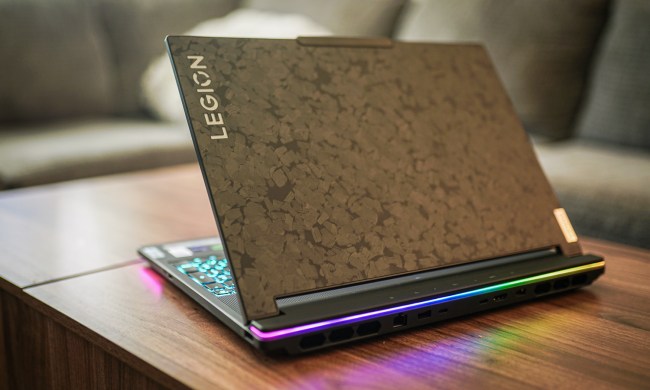“The Yoga S940 is a subtle laptop with a few tricks up its sleeve.”
- Extremely thin bezels
- Thin and lightweight design
- Upward notch includes infrared camera
- Curved display edges look great
- Front-facing speakers
- Way too expensive
- Low travel keyboard isn’t our favorite
Lenovo makes great laptops, whether they’re ThinkPad or Yoga machines, but they’re not always trend-setters. The company’s latest at CES 2019, the Yoga S940, seeks to change that.
With ultra-slim bezels and unique curved glass along the edges of the display, the Yoga S940 has a couple of tricks up its sleeve. But for a starting price of $1,500, are they enough to make this one a hit?
One inverted notch, two purposes
When closed, the Yoga S940 looks just like every other Yoga laptop. It’s grey, thin, conservative. Still, there’s a something new is in the works. Look closely, and you’ll see lip along the top edge of the lid with the laptop’s name etched in it. Not only is it a nice bit of branding for an otherwise nondescript laptop, it has a couple of interesting practical uses.
Obviously, it provides an easy grip for opening the laptop, which swings smoothly even with one finger. Once open, though, you’ll see the real purpose as an inverted notch. The bump gives just enough room to squeeze in a webcam and infrared Windows Hello camera.
The result is a frame with a 90 percent screen-to-body ratio, second only to the new Acer Swift 7. While this solution won’t win any engineering awards, the inverted notch isn’t as distracting as you might assume. In this case, it works.
Lenovo’s Yoga S940 also brings other, more subtle innovation. Examine the display, and you’ll find curved glass that hugs the edge of the frame on each side. It’s similar to a Samsung Galaxy smartphone, and a clever way to make the bezels feel smaller. We think other laptops will move to copy the design. It looks great.
The inverted notch isn’t as distracting as you might assume.
Speaking of the display, the Yoga S940 comes with a 13.9-inch IPS screen. You’ll have two options: The entry-level, which is a 400-nit 1080p with Dolby Vision support — or the 500-nit HDR400 4K model. The screen resolution and aspect ratio are what make this screen unique. It’s 16:10, which is the standard MacBook size. That also makes it the first 4K display we’ve seen in that aspect ratio. It’s a happy middle-ground that we quite like.
That also provides a bit more room in the palmrests to comfortably place your hands while typing. The keyboard itself isn’t anything spectacular — in fact, it has low travel, similar to previous Yoga notebooks like the Yoga S730. It’s not our favorite, though the layout is familiar enough to keep the learning curve down. The touchpad, on the other hand, is spacious and felt responsive in our short time with the device.
Quad-core power at your disposal
Though it might sound like a lighter, mobile-friendly laptop in the vein of Apple’s MacBook, the Yoga S940 has all the power of a modern ultrabook. Using Intel’s latest Whiskey Lake U-series processors and 8GB of RAM, the machine is snappy and responsive. The system can be configured with either a Core i5 or Core i7 (and up to 16GB of RAM), though both are quad-core processors with plenty of gusto. The same goes for storage, which starts at a 256GB NVMe PCIe SSD but can be configured up to 2TB.

Audio quality is a surprising high point. Like the new ThinkPads, the Yoga S940 fires audio up at your face instead of down at your desk. That’s a big upgrade over the S730 and joins an elite group of laptops including the Razer Blade Stealth and MacBook Air. On top of that, they are Dolby Atmos, so you know the quality is there.
The Yoga S940 fires audio up at your face instead of down at your desk.
Sounds good so far, right? Well, it is. Until you hear the price. Configurations start at a whopping $1,500. That’s a commanding entry-level price that’s far higher than some competitors. In fact, other laptops even within Lenovo’s own lineup make more sense from a value perspective. Take the IdeaPad 730S or the Yoga S730, for example. Both have the exact same specs as the S940 — as well as a lot of the same features. What you’re really paying for with the Yoga S940 is he cutting-edge design.
Is design worth the steep increase in price? We won’t know for sure until we get the system in for full review leading up to its launch date in May of 2019.







